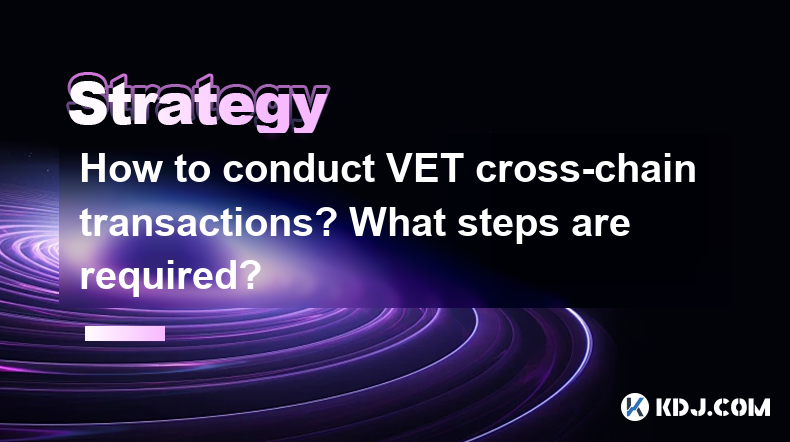-
 bitcoin
bitcoin $124586.364639 USD
0.62% -
 ethereum
ethereum $4670.671710 USD
3.33% -
 xrp
xrp $2.983701 USD
0.18% -
 tether
tether $1.000175 USD
-0.03% -
 bnb
bnb $1209.430642 USD
2.76% -
 solana
solana $231.365861 USD
0.51% -
 usd-coin
usd-coin $0.999665 USD
-0.02% -
 dogecoin
dogecoin $0.264657 USD
4.46% -
 tron
tron $0.346415 USD
1.60% -
 cardano
cardano $0.871586 USD
3.70% -
 chainlink
chainlink $23.451270 USD
7.56% -
 hyperliquid
hyperliquid $46.860071 USD
-2.96% -
 ethena-usde
ethena-usde $1.000120 USD
0.04% -
 sui
sui $3.611279 USD
1.08% -
 stellar
stellar $0.407149 USD
0.96%
How to conduct VET cross-chain transactions? What steps are required?
To conduct VET cross-chain transactions, use a reliable bridge like VeChainThor Bridge, ensure sufficient VET for fees, and double-check destination addresses for security.
May 05, 2025 at 11:49 pm

Conducting VET cross-chain transactions involves transferring VeChainThor (VET) tokens between different blockchains. This process can be complex, but with the right tools and understanding, it can be executed smoothly. In this article, we will explore the steps required to perform VET cross-chain transactions, ensuring that you have a comprehensive guide to follow.
Understanding Cross-Chain Transactions
Cross-chain transactions involve moving assets from one blockchain to another. This is crucial for users who wish to utilize their VET tokens across different ecosystems. The VeChainThor blockchain supports cross-chain transactions to enhance interoperability and user flexibility. To conduct these transactions, you'll need to use a bridge or a cross-chain protocol that supports VET.
Preparing for a VET Cross-Chain Transaction
Before you begin, ensure you have the following:
- A VeChainThor wallet that supports cross-chain transactions.
- Sufficient VET in your wallet to cover transaction fees.
- Access to a cross-chain bridge that supports VET transfers.
It's essential to choose a reliable bridge to ensure the security of your transactions. Some popular options include the VeChainThor Bridge and other third-party solutions like Multichain (formerly Anyswap).
Step-by-Step Guide to Conducting a VET Cross-Chain Transaction
To conduct a VET cross-chain transaction, follow these detailed steps:
- Connect to the VeChainThor Network:
- Open your VeChainThor wallet and ensure it is connected to the VeChainThor network. This is the starting point for your cross-chain transaction.
- Select the Cross-Chain Bridge:
- Navigate to the cross-chain bridge of your choice. For this example, we'll use the VeChainThor Bridge.
- Enter the VeChainThor Bridge website and connect your VeChainThor wallet to the bridge.
- Initiate the Cross-Chain Transaction:
- On the bridge interface, select VET as the asset you want to transfer.
- Enter the amount of VET you wish to transfer and the destination blockchain.
- Confirm the transaction details, including any fees that may be required.
- Authorize the Transaction:
- Your VeChainThor wallet will prompt you to authorize the transaction. Review the details carefully and confirm the transaction.
- Wait for the transaction to be processed on the VeChainThor network.
- Monitor the Transaction:
- Once the transaction is initiated on the VeChainThor network, it will be processed by the bridge.
- Monitor the status of the transaction on the bridge's interface until it is confirmed on the destination blockchain.
- Receive the Tokens on the Destination Blockchain:
- Once the transaction is complete, the VET tokens will be available on the destination blockchain.
- You can now use your tokens on the new blockchain as needed.
Common Issues and Troubleshooting
Cross-chain transactions can sometimes encounter issues. Here are some common problems and how to address them:
- Transaction Stuck:
- If your transaction appears stuck, check the bridge's status page for any known issues.
- Ensure you have sufficient VET for transaction fees, as insufficient funds can cause delays.
- Incorrect Destination Address:
- Double-check the destination address before confirming the transaction. An incorrect address can result in lost funds.
- If you enter the wrong address, contact the bridge support immediately for assistance.
- High Network Congestion:
- During times of high network congestion, transactions may take longer to process.
- Consider waiting for less congested periods or adjusting your transaction fee to prioritize your transaction.
Security Considerations
When conducting VET cross-chain transactions, security should be a top priority. Here are some tips to keep your transactions secure:
- Use Trusted Bridges:
- Only use bridges that have a proven track record and are recommended by the VeChain community.
- Verify Addresses:
- Always double-check the destination address to prevent sending your VET to the wrong blockchain.
- Keep Software Updated:
- Ensure your VeChainThor wallet and any bridge software are up to date to benefit from the latest security patches.
- Protect Your Private Keys:
- Never share your private keys or seed phrases with anyone. Keep them secure and offline whenever possible.
Additional Resources and Support
For further assistance with VET cross-chain transactions, consider the following resources:
- VeChainThor Official Documentation:
- The official VeChainThor documentation provides detailed guides on cross-chain transactions and other functionalities.
- Community Forums:
- Engage with the VeChain community on forums like Reddit or the VeChain official Discord to seek advice and share experiences.
- Bridge Support:
- Most bridges offer customer support to help resolve issues. Don't hesitate to reach out if you encounter problems.
Frequently Asked Questions
Q1: Can I transfer VET to any blockchain using a cross-chain bridge?A1: Not all blockchains support VET transfers. You should check the compatibility of the destination blockchain with the bridge you are using. Most bridges will list the supported blockchains on their website.
Q2: How long does a VET cross-chain transaction typically take?A2: The duration of a VET cross-chain transaction can vary based on network congestion and the efficiency of the bridge. Generally, transactions can take anywhere from a few minutes to several hours.
Q3: Are there any risks associated with cross-chain transactions?A3: Yes, there are risks such as transaction failures, high fees, and potential security vulnerabilities in the bridge. Always use reputable bridges and keep your software updated to minimize these risks.
Q4: Can I reverse a VET cross-chain transaction if I make a mistake?A4: Once a cross-chain transaction is confirmed, it is typically irreversible. Therefore, it's crucial to double-check all transaction details before confirming. If you encounter issues, contact the bridge's support team immediately.
Disclaimer:info@kdj.com
The information provided is not trading advice. kdj.com does not assume any responsibility for any investments made based on the information provided in this article. Cryptocurrencies are highly volatile and it is highly recommended that you invest with caution after thorough research!
If you believe that the content used on this website infringes your copyright, please contact us immediately (info@kdj.com) and we will delete it promptly.
- BlockDAG, DOGE, HYPE Sponsorship: Crypto Trends Shaping 2025
- 2025-10-01 00:25:13
- Deutsche Börse and Circle: A StableCoin Adoption Powerhouse in Europe
- 2025-10-01 00:25:13
- BlockDAG's Presale Buzz: Is It the Crypto to Watch in October 2025?
- 2025-10-01 00:30:13
- Bitcoin, Crypto, and IQ: When Genius Meets Digital Gold?
- 2025-10-01 00:30:13
- Stablecoins, American Innovation, and Wallet Tokens: The Next Frontier
- 2025-10-01 00:35:12
- NBU, Coins, and Crypto in Ukraine: A New Yorker's Take
- 2025-10-01 00:45:14
Related knowledge

Practical parameter settings for a Bitcoin multi-timeframe moving average system
Sep 18,2025 at 10:54pm
Optimizing Timeframe Combinations for Bitcoin Trading1. Selecting appropriate timeframes is crucial when building a multi-timeframe moving average sys...

How can I filter out false breakouts in Dogecoin high-frequency trading?
Sep 22,2025 at 01:00am
Understanding False Breakouts in Dogecoin Trading1. A false breakout occurs when Dogecoin's price appears to move beyond a defined support or resistan...

Techniques for identifying tops and bottoms in the Bitcoin on-chain NVT model
Sep 20,2025 at 07:54pm
Understanding the NVT Model in Bitcoin Analysis1. The Network Value to Transactions (NVT) ratio is often described as the 'P/E ratio' of the cryptocur...

What does the surge in open interest in Bitcoincoin futures mean?
Sep 20,2025 at 11:18pm
Understanding the Surge in Dogecoin Futures Open Interest1. A surge in open interest within Dogecoin futures indicates a growing number of active cont...

How can I use the Ethereum USDT premium to gauge market sentiment?
Sep 18,2025 at 11:55pm
Understanding the Ethereum USDT Premium1. The Ethereum USDT premium refers to the price difference between USDT (Tether) traded on Ethereum-based plat...

What should I do if Ethereum staking yields decline?
Sep 20,2025 at 06:18am
Understanding the Causes Behind Declining Ethereum Staking Yields1. The Ethereum network transitioned to a proof-of-stake consensus mechanism with the...

Practical parameter settings for a Bitcoin multi-timeframe moving average system
Sep 18,2025 at 10:54pm
Optimizing Timeframe Combinations for Bitcoin Trading1. Selecting appropriate timeframes is crucial when building a multi-timeframe moving average sys...

How can I filter out false breakouts in Dogecoin high-frequency trading?
Sep 22,2025 at 01:00am
Understanding False Breakouts in Dogecoin Trading1. A false breakout occurs when Dogecoin's price appears to move beyond a defined support or resistan...

Techniques for identifying tops and bottoms in the Bitcoin on-chain NVT model
Sep 20,2025 at 07:54pm
Understanding the NVT Model in Bitcoin Analysis1. The Network Value to Transactions (NVT) ratio is often described as the 'P/E ratio' of the cryptocur...

What does the surge in open interest in Bitcoincoin futures mean?
Sep 20,2025 at 11:18pm
Understanding the Surge in Dogecoin Futures Open Interest1. A surge in open interest within Dogecoin futures indicates a growing number of active cont...

How can I use the Ethereum USDT premium to gauge market sentiment?
Sep 18,2025 at 11:55pm
Understanding the Ethereum USDT Premium1. The Ethereum USDT premium refers to the price difference between USDT (Tether) traded on Ethereum-based plat...

What should I do if Ethereum staking yields decline?
Sep 20,2025 at 06:18am
Understanding the Causes Behind Declining Ethereum Staking Yields1. The Ethereum network transitioned to a proof-of-stake consensus mechanism with the...
See all articles










































































